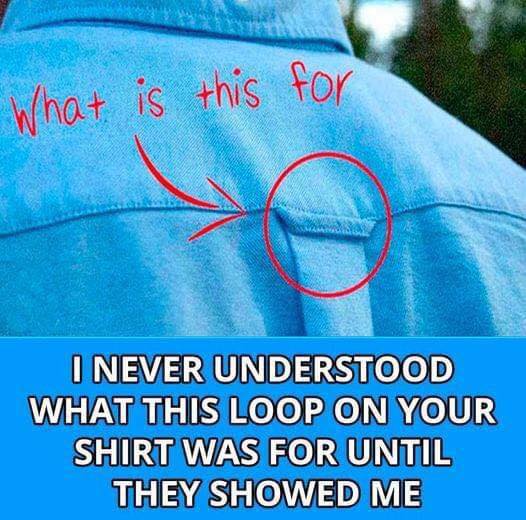Have you ever noticed the small loop located on the back of certain clothing items? Men’s dress shirts, in particular, often feature this loop, and while it might seem like a decorative detail, it actually has a fascinating history and practical uses that many people may not be aware of. This unassuming feature, commonly referred to as the “locker loop,” has evolved over time, gaining various purposes and cultural meanings.
Traditionally, shirts with button-down fronts are seen as versatile clothing items that can be styled casually or dressed up. Paired with the right pair of jeans and accessories, these shirts can transition seamlessly from relaxed to elegant attire, making them a staple in many wardrobes. However, beyond their stylistic flexibility, the inclusion of a loop on the back of these shirts was originally intended for convenience, particularly for individuals with active lifestyles.
For instance, gym-goers found the loop extremely practical. Imagine arriving at a gym or a location without a designated space for hanging clothes. Instead of scrambling to find a wardrobe or worrying about where to keep your shirt, the loop made it easy to take off the shirt and hang it securely on a hook or peg. This small but thoughtful addition eliminated the hassle of managing clothes while on the go, offering a simple yet effective solution.
Interestingly, the loop also carried a symbolic meaning in some social contexts. In earlier decades, particularly during the mid-20th century, the removal of the loop from a man’s shirt was considered a subtle indicator of his relationship status. If the loop was cut off or absent, it signaled that the wearer was in a committed relationship, suggesting that he no longer needed a convenient way to hang his shirt, as his partner presumably took on responsibilities for such care. While this use has faded over time, it provides a charming glimpse into how clothing was intertwined with social customs and personal identity.
Today, the loop is mostly seen as an aesthetic detail, a remnant of its practical origins. As American fashion has evolved over the last century, the loop’s initial purpose and symbolism have largely disappeared. However, its presence on modern dress shirts offers an opportunity to explore a unique aspect of clothing history that connects functionality with fashion.
The loop’s roots in American menswear can be traced back to sailors. Known as “locker loops” or occasionally “fairy loops,” these features were reportedly used by American sailors to hang their shirts aboard ships. Limited space on naval vessels meant that clothing needed to be stored efficiently, and these loops offered a straightforward way to keep shirts neatly hung without taking up additional room. This maritime practicality eventually made its way into mainstream fashion, where it took on new life as part of the “preppy” style movement.
In the 1960s, the locker loop became a standard feature in Ivy League menswear, an essential detail for button-down and oxford shirts popular among college students. These shirts, with their polished yet approachable style, became synonymous with the collegiate look, which combined neat tailoring with casual sophistication. As the preppy style gained traction nationwide, the loop transitioned from a purely functional element to a cultural symbol associated with a specific social and fashion identity.
The brand Gant is often credited with popularizing the locker loop as part of this Ivy League aesthetic. According to the company’s history, the founder first introduced the feature while collaborating with Yale University to design shirts for male students. The practicality and distinctiveness of the loop caught on, and soon other universities and clothing manufacturers adopted the detail. The loops, strategically sewn onto the middle yoke of the shirts, became an iconic part of American menswear, blending convenience with tradition.
Over time, the locker loop earned a playful reputation as well. Its placement on the back of the shirt often invites interaction, whether it’s someone tugging on it or spinning the shirt around their finger. While the loop’s role as a functional tool for hanging clothes or a relationship status indicator may have diminished, its enduring presence serves as a nod to the rich history of men’s fashion and the subtle details that make clothing both practical and meaningful.
In today’s fashion landscape, where trends come and go rapidly, small features like the locker loop remind us of the enduring value of thoughtful design. They also highlight the fascinating ways that clothing reflects societal changes, blending utility with cultural expression. From its nautical beginnings to its place in collegiate fashion and beyond, the humble locker loop has quietly left an indelible mark on men’s style.
As we reflect on the evolution of American fashion, it’s interesting to consider the journey of this small but impactful detail. While many aspects of clothing have changed dramatically over the decades, some features, like the locker loop, have persisted, adapting to new contexts and purposes. Whether viewed as a practical addition, a symbol of tradition, or simply an extra piece of fabric, the loop offers a unique perspective on the intersection of design, culture, and everyday life. By looking closely at these details, we can appreciate how even the smallest elements of clothing carry stories that connect us to the past while continuing to shape our present.
